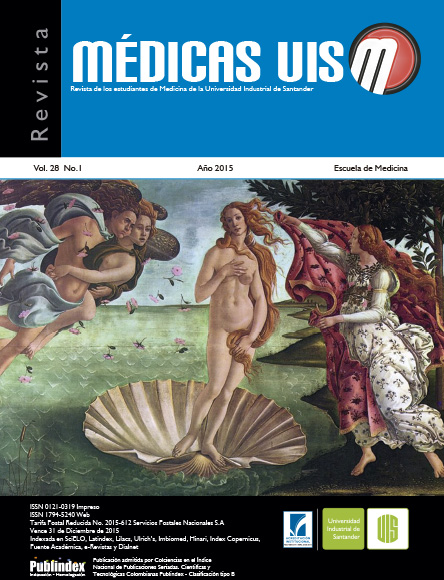Abstract
Neonatal jaundice has many possible diagnoses according to the predominant type of bilirubin. The ABO incompatibility is one of the most common causes of hemolytic disease due to indirect hyperbilirubinemia. Clinical manifestations vary from asymptomatic to severe neurological symptoms, even leading with irreversible damage. Phototherapy achieves a significant decrease of bilirubin, with a low probability of side effects; however, some patients require invasive methods such as exchange transfusion. High doses of Intravenous immunoglobulin no is a treatment used nowadays. The aim of this review is to evidence there is enough literature supporting intravenous immunoglobulin as a valid alternative to treat hyperbilirubinemia by ABO incompatibility, in order to be able to reduce invasive procedures in newborns such as exchange transfusion. MÉD.UIS. 2015;28(1):91-7.
Keywords: Hyperbilirubinemia, Neonatal. Jaundice, Neonatal. Immunoglobulin G. Blood Group Incompatibility. Hemolysis.
References
Valdés M, Egea J. Protocolo diagnóstico de la ictericia obstructiva. Medicine. 2008;10(8):533–5.
Ardakani SB, Dana VG, Ziaee V, Ashitiani MT, Djavid GE, Alijani M. Bilirubin/Albumin ratio for predicting acute bilirubin-induced neurologic dysfunction. Iran J Pediatr. 2011;21(1):28–32.
Watchko JF. Identification of neonates at risk for hazardous hyperbilirubinemia: emerging clinical insights. Pediatr Clin North Am. 2009;56(3):671–87.
Núñez-Batalla F, Carro-Fernández P, Eva M, Teresa A. Incidencia de hipoacusia secundaria a hiperbilirrubinemia en un programa de cribado auditivo neonatal universal basado en otoemisiones acústicas y potenciales evocados auditivos. Acta Otorrinolaringol Esp. 2008;59(3):108-13.
Anderson D, Ali K, Blanchette V, Brouwers M, Couban S, Radmoor P, et al. Guidelines on the use of intravenous immune globulin for hematologic conditions. Transfus Med Rev. 2007;21(2 Suppl 1):S9–56.
Ives NK. Management of neonatal jaundice. Paediatr Child Health (Oxford). 2011;21(6):270–6.
Sarici SU, Yurdakök M, Serdar MA, Oran O, Erdem G, Tekinalp G, et al. An early (sixth-hour) serum bilirubin measurement is useful in predicting the development of significant hyperbilirubinemia and severe ABO hemolytic disease in a selective high-risk population of newborns with ABO incompatibility. Pediatrics. 2002;109(4):e53.
Bhutani VK, Johnson L. The jaundiced newborn in the emergency department: Prevention of kernicterus. Clin Pediatr Emerg Med. 2008;9(3):149–59.
Geaghan SM. Diagnostic laboratory technologies for theetus and neonate with soimmunization. Semin Perinatol. 2011;35(3):148–54.
Nancy R, Nuyt AM, Panagopoulos A, Hume HA. Exchange transfusion in the infant. IN: Hillyer CD, Luban NLC, Strauss RG. Handbook of Pediatric Transfusion Medicine. San Diego: Elsevier; 2004. 159–65.
Marco N, Vizcaíno C, Quiles JL, Alós A , Vargas F. Ictericia neonatal: Evaluación clínica de un bilirrubinómetro transcutaneo. An Pediatr (Barc). 2009;71(2):157–60.
Bhutani VK, Johnson L, Sivieri EM. Predictive ability of a predischarge hour-specific serum bilirubin for subsequent significant hyperbilirubinemia in healthy term and near-term newborns. Pediatrics. 1999;103(1):6-14.
Rennie J, Burman-Roy S, Murphy MS; Guideline Development Group. Neonatal jaundice: summary of NICE guidance. BMJ. 2010;340:c2409.
Martínez-Biarge M, García-Alix A. Hiperbilirrubinemia en el recién nacido a término. An Pediatr Contin. 2005;3(5):298–302.
Guzmán JM, Tofé I, Gómez E. Exanguinotransfusión. An Pediatr Contin. 2009;7(5):297–302.
Provan D, Nokes TJC, Agrawa S, Winer J, Wood P. Clinical guidelines for immunoglobulin use. Second edition. Scotlan: Scotland; 2009.
Jolles S, Sewell WAC, Misbah SA. Clinical uses of intravenous immunoglobulin. Clin Exp Immunol. 2005; 142(1):1–11.
Stiehm ER. Adverse effects of human immunoglobulin therapy. Transfus Med Rev. 2013; 27(3):171–8.
Cleary AG, Brown B, Minards J, Sills J, Bolton-Maggs P. Systematic review of intravenous immunoglobulin in haemolytic disease of the newborn. Arch Dis Child Fetal Neonatal Ed. 2003; 88(5):F444; author reply F445.
